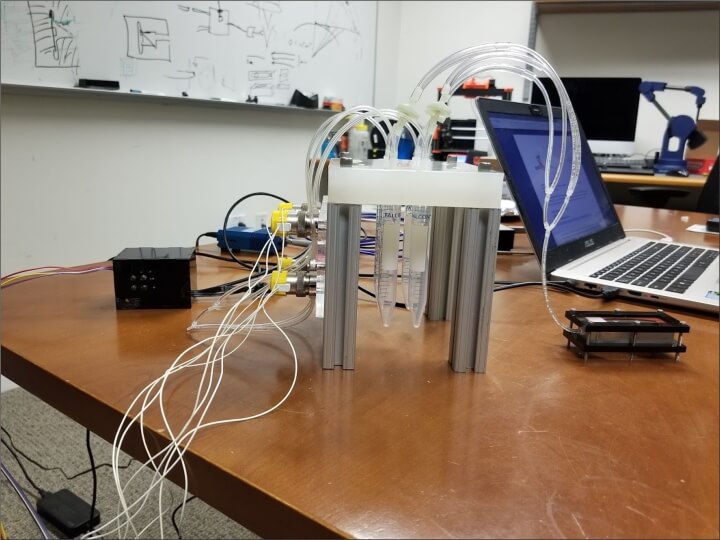News
Consider this — there is no cheap, at-home device that can tell you milk has gone bad faster than your nose. One whiff and you know that the milk has gone rancid. Humans have created technologies that allow us to see distant stars and single atoms but when it comes to smell, the nose still tends to know best.
Portable sensors that mimic the olfactory system, known as e-noses, could be used to identify volatile compounds in the air. However, these devices aren’t widely used so far because they can be large, have complicated manufacturing, are only able to sense one or a few compounds, or have inaccuracies. Toxic spills, such as the train derailment in East Palestine, Ohio in February, highlight the need for portable and inexpensive sensors that can rapidly and accurately identify volatile compounds on site.
Now, a research team led by the Harvard John A. Paulson School of Engineering and Applied Sciences (SEAS), has introduced an easy-to-manufacture e-nose that can quickly and accurately ‘sniff-out’ volatile compounds, such as the ubiquitous volatile organic compounds (VOCs). The sensor is the first of its kind to showcase both passive and active sensing with a single sensor and use machine learning to identify a range of molecules and their mixtures.
“Distinctive to our approach, our sensor implements biologically inspired ‘sniffing’. It generates patterns of inhale-exhale sequences, mimicking critical odor discrimination mechanism used by living organisms, which involves not only chemical sensing but also dynamic mass transport processes,” said Joanna Aizenberg, Amy Smith Berylson Professor of Materials Science at SEAS, Professor of Chemistry & Chemical Biology, and lead author of the study. “Our results show that this unique feature substantially augments the detection power of any artificial nose, with broad applications in breathalyzers for disease diagnostics, monitoring air quality and hazardous waste, or detecting food spoilage.”
The research is published in the Proceedings of the National Academy of Sciences.
VOCs: benign, deadly, life saving
VOCs are emitted into the air from both natural and human-made sources. They are omnipresent – used for everything from cosmetics to furniture and are emitted from agricultural activities, car exhaust, wildfires, industrial processes and more. VOCs range from benign to deadly, so measuring their presence, concentration, and identity is important for monitoring indoor and outdoor air quality and hazardous waste. Recent research has also found that measuring VOCs in breath and urine can detect some cancers in the early stages.
Today, most devices used to identify and quantify VOCs in the air rely on sophisticated instruments which tend to be bulky and need specialists to operate and interpret. Researchers are developing e-noses as portable, practical, reliable, and easy-to-read alternatives.
Rather than try to mimic the millions of individual receptors in the nose — which can lead to bulky and hard-to- manufacture devices — Aizenberg and her team use a single sensor to detect the optical properties of the molecules that make up different VOCs.
The experimental setup. The sensor sits atop the small glass box (left). A small amount of liquid containing VOCs (right) is added to the box, where it is drawn into the sensor via sniffing. (Credit: Aizenberg Lab/Harvard SEAS)
The sensor has alternating layers of silica and titania nanoparticles which have tiny pores between them. The sensor sits atop a small glass box into which a small amount of liquid containing VOCs is added. As the liquid evaporates, the gas moves into the pores of the sensor, where it adsorbs and condenses. As these processes occur, the refractive indices of each of the sensor layers increase, which causes the color of the sensor to change.
“The problem is that the refractive indices of different gasses are very similar. This means that the color of the sensor is going to look practically identical at the end of an experiment, no matter which gas you use,” said Ida Pavlichenko, co-first author of the paper and the originator of the project during her time as postdoctoral fellow in Aizenberg’s lab.
However, the team realized that changes to the sensor's refractive index evolves differently for different compounds over time, generating a kind of dynamic spectral fingerprint for each VOC.
“The rates of all processes – from the formation of a droplet at the bottom of the chamber to its evaporation, rise through the chamber, and arrival at the sensor – depend on the unique microscopic forces between the molecules that are present,” said Anna V. Shneidman, a research associate in the Aizenberg lab and co-first author of the paper. “Therefore, changes in the sensor color over time are going to look very different even for very similar VOCs like the 5-carbon molecule pentane and 8-carbon molecule octane.”
The team identified specific features in the dynamic reflection spectrum of each compound and used those features to train a machine learning algorithm to identify specific VOCs, determine the concentration of each VOC in a mixed liquid, and accurately predict physical properties of volatile liquids.
Machine learning enhances the ability for even these simple sensors to do remarkable things.
“Machine learning enhances the ability for even these simple sensors to do remarkable things,” said Shneidman.
“In this work we use a simplified model to map from odor space in the experiments to chemical species. With larger datasets, we will be able to make more sophisticated models with finer discriminatory power,” said Michael P. Brenner, Michael F. Cronin Professor of Applied Mathematics and Applied Physics at SEAS and Professor of Physics, and co-author of the paper.
Take a whiff
To speed up the sensing process and provide the machine learning algorithm with even richer data, the team turned to sniffing.
If you’ve ever watched a dog sniff something in its path, you’ll know that dogs employ both quick, staccato bursts of sniffing and longer inhales.
“Dogs and other mammals, including humans, can actively modulate the timing, rate, and depth of sniffing. That behavioral observation, as well as many neuroscience experiments, clearly indicate that brains make use of the dynamics of odor sensation to make inferences about smells,” said Venkatesh Murthy, the Raymond Leo Erikson Life Sciences Professor of Molecular & Cellular Biology and the Paul J Finnegan Family Director of the Center for Brain Science at Harvard, and co-author of the paper.
The researchers found that different patterns of sniffing also change how the molecules interact with the sensor. The rates of diffusion, absorption, condensation, and desorption change with different lengths of inhalations and exhalations.
“With different sniffs and exhales, we can start to tell apart compounds that were previously difficult to differentiate,” said Haritosh Patel, a PhD candidate at SEAS and co-first author of the paper. “In nature, the concentrations of these compounds vary quite dramatically. One type of compound may require a shorter sniffing pattern such that you don’t overexpose your sensor, whereas in scenarios where concentrations are very small, you might want to take longer breaths to saturate the sensor.”
Our work is a blueprint to build more efficient and cheaper e-noses.
"The size, portability and ease of manufacture makes our sensor more versatile than many commercial sensors and adaptable to a broad range of compounds and odors,” said Soeren Brandt, a former graduate student at SEAS and co-first author of the paper. “Compared to other e-noses, it is easier to make, use, reuse, and maintain. Our work is a blueprint to build more efficient and cheaper e-noses."
Harvard’s Office of Technology Development has protected the intellectual property arising from these studies and is exploring commercialization opportunities.
The paper was co-authored by Austin Tripp, Timothy Wong, Sean Lazaro, Ethan Thompson, Aubrey Maltz, Thomas Storwick, Holden Beggs, Katalin Szendrei-Temesi, Bettina V. Lotsch, Nadir Kaplan, and Claas W. Visser.
The research was supported by the National Science Foundation through the Harvard University Materials Research Science and Engineering Center under award DMR-2011754 and the Kavli Institute for Bionano Science & Technology at Harvard University.
Topics: Applied Mathematics, Computer Science, Materials, Technology
Cutting-edge science delivered direct to your inbox.
Join the Harvard SEAS mailing list.
Scientist Profiles
Joanna Aizenberg
Amy Smith Berylson Professor of Materials Science and Professor of Chemistry & Chemical Biology
Michael P. Brenner
Catalyst Professor of Applied Mathematics and Applied Physics and of Physics
Press Contact
Leah Burrows | 617-496-1351 | lburrows@seas.harvard.edu





